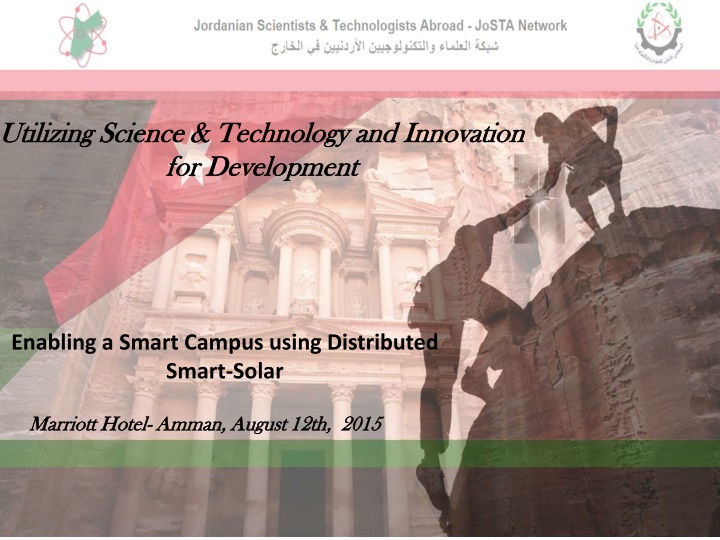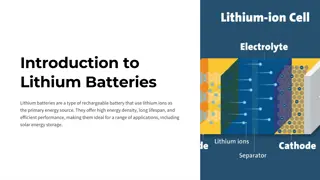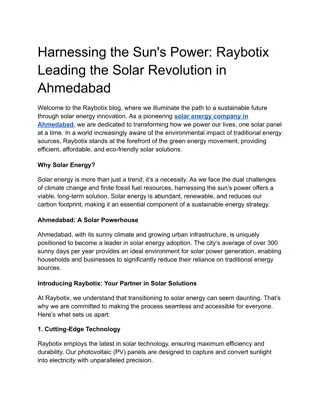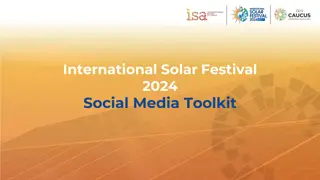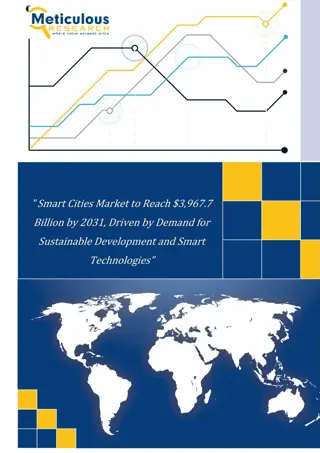Enabling Smart Solar Campus Development and Innovation
The project aims to harvest solar energy using a smart micro-grid system connected through Wi-Fi, distributing solar PV across various installations to research PV solar energy technology and its impact. Collaborating with local experts, the project will provide 50kW of electricity to the GJU campus, training technicians and students to maintain the system, setting a model for future campus innovation.
Uploaded on Mar 11, 2025 | 1 Views
Download Presentation

Please find below an Image/Link to download the presentation.
The content on the website is provided AS IS for your information and personal use only. It may not be sold, licensed, or shared on other websites without obtaining consent from the author.If you encounter any issues during the download, it is possible that the publisher has removed the file from their server.
You are allowed to download the files provided on this website for personal or commercial use, subject to the condition that they are used lawfully. All files are the property of their respective owners.
The content on the website is provided AS IS for your information and personal use only. It may not be sold, licensed, or shared on other websites without obtaining consent from the author.
E N D
Presentation Transcript
Utilizing Science & Technology Utilizing Science & Technology and for Development for Development and Innovation Innovation Enabling a Smart Campus using Distributed Smart-Solar Marriott Hotel Marriott Hotel- - Amman, Amman, August 12th August 12th, , 2015 2015
Project Team Project Team Ahmad Harb, Ahmad Harb, German Jordanian University, GJU, Amman Jordan Issa Issa Batarseh Batarseh, , University of Central Florida, UCF, Orlando Florida, USA
Brief Description Brief Description The project will: - Harvest solar energy with LED light control in a smart micro-grid wi- fi connected, integrated monitoring system . - Distribute solar PV over various types of installations including roof tops, parking spaces, light poles, walkways, Solar-trees. - Serve as a platform for research in PV solar energy technology, the impact of weather conditions, stability of the micro-grid. - Researchers from the German Jordanian University (GJU) and the University of Central Florida (UCF) will collaborate with local Jordanian PV manufacturers and other local experts and technicians to develop, establish, and maintain the smart-solar campus.
Brief Description Brief Description - When ready the smart-solar system will provide nearly 50kW of electricity to the GJU campus which is 2-5% of its annual usage. - The GJU-UCF team will develop, install, and maintain the smart-campus. University technicians and students will be trained to operate and maintain the installations. - The smart-solar system will be the first of its kind in a Jordanian higher education institution that will serve as a model for engineering and ICT innovation in campuses.
Justifications Justifications - - Jordan s current energy crisis makes it imperative to seek alternative sources The abundant sunshine makes solar harvesting the most attractive and reliable energy option. Smart-Solar is a pollution-free, noise-free, environment-friendly, low-maintenance method for meeting the university s electricity needs. The distributed smart-solar installations can be used as a model for training university technicians as well as engineering and ICT students of GJU and other institutions. The cost for smart solar option, and R&D opportunities justify upfront development and investment costs. The necessary educational background and the clear success in Jordan s ICT sector, will help make the project a success. As one of the most economically, politically, and socially stable countries in the region today Jordan would be the most obvious choice for large scale PV systems - - - - -
Objectives Objectives - To initiate cooperation between GJU and UCF for the building and operation of a Smart-Solar Campus that utilizes solar energy instead of state-supplied electricity. - To develop and operate grid-connected and off-grid distributed solar installations in various areas within the GJU campus. - To install new state-of-the-art inverter technologies that serve as a model for integrated and cost-effective power generation for light control and monitoring. - Build a platform for R&D activities in solar energy harvesting in Jordan.
Scope of work Scope of work Study the impact of micro-inverter based PV system on the power grid. Study the LED control, conversion efficiency and inverter reliability under various weather conditions including: shading, sand storms, and temperature. Study different coating materials to improve energy harvesting. Develop new models for PV harvesting under various weather conditions. Development of high-level intelligent control strategies to make the micro-grid safer, more reliable, and more secure.
Duration Duration Estimated Budget Estimated Budget Duration: The project is expected to last two years as Duration: The project is expected to last two years as follows: follows: 3 Months 3 Months - - Study and identifying the installation sites Study and identifying the installation sites 3 Months Identify and Design of each installed capacity and type 6 Months Installation of the entire system and data harvesting 6 Months Initial data mentoring and study of weather impact - Installing various coating material. 6 Months Continue data collection and studies. Estimated Budget : JD 200,000 Estimated Budget : JD 200,000 This will include purchasing of various PV systems and LED controllers.
Methodology of Implementation Methodology of Implementation Study Study and identifying the installation and identifying the installation sites to include spaces, light poles, walkways, Solar-trees. sites to include roof tops, parking Identify and design of each installed capacity and type, and installing the data monitoring and control system. Design relevant experiments for various weather condition to study their impact Studies on different coating materials effecting on transmittance Data analysis and model development
Expected output Expected output - Reduction of costs by producing clean, environmentally friendly, cheap energy to power the GJU campus Reduction of dependency on conventional electricity sources which are expensive and polluting Low-cost and easy maintenance that require occasional cleaning of solar panels and monitoring New models for power grid with distributed PV installations based on microinverter technologies, dust accumulation and shading. Dissemination of new models that will result in the development of new R&D topics in PV systems and the use of ICT in micro-grid designs. - - - -
Impact Impact Environmental With ever dwindling natural resources, already scarce in Jordan, and increasing demands for power, the need to seek out viable alternative and clean sources of renewable energy. PV produces clean energy with improved LED controllers Technical Impact Developing of new models for PV harvesting under various weather conditions, and the impact of new micro-inverter technology on the grid stability. Developing new software to model smart-grid conditions under different loads Economic & Social Reduce Jordan s dependence on imported energy. Help improve PV penetration and smart-grid understanding that ultimately will support micro- businesses, local industries and individual entrepreneurs, resulting in a positive impact on the economy, industry, agriculture, and even individuals in Jordan and the region.
Sustainability Sustainability - Although upfront costs may seem high, the long-term benefits and sustainability of installations such as the smart- solar make the initial investment highly desirable and worthwhile. - The harvested solar energy and LED control will produce annual savings to make the project sustainable. - Maintenance is low-cost, involving the occasional cleaning of the solar panels and monitoring the system. - Improved energy distribution efficiency 10-15% due to saving on losses
Action Plan Action Plan Identifying site selection for PV and street light controllers through out the university campus. Design and implementation phase Set up the monitoring control unit. Data gathering and modeling design. Summary and result dissemination phase.
